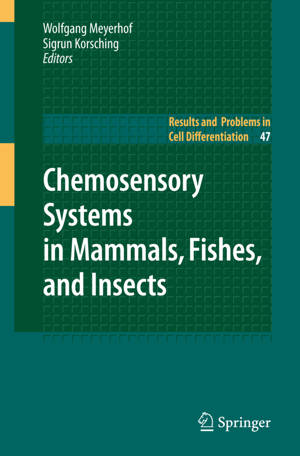
- Afhalen na 1 uur in een winkel met voorraad
- Gratis thuislevering in België vanaf € 30
- Ruim aanbod met 7 miljoen producten
- Afhalen na 1 uur in een winkel met voorraad
- Gratis thuislevering in België vanaf € 30
- Ruim aanbod met 7 miljoen producten
Zoeken
Chemosensory Systems in Mammals, Fishes, and Insects
€ 279,45
+ 558 punten
Omschrijving
The sense of smell has an essential role in locating food, detecting predators, navigating, and communicating social information. Accordingly, the olfactory system has evolved complex repertoires of receptors to face these problems. Although the sense of taste has less far-reaching tasks, they are every bit as essential for the animals well-being, allowing it to reject toxic materials and to select nutritionally valuable food. The last decade has seen a massive advance in understanding the molecular logic of chemosensory information processing, beyond that already achieved in the rst few years following Linda Bucks discovery of odorant receptors. Shortly afterwards, the major principles of olfactory representation had been established in mammals as the one neuron/ one receptor rule and the convergence of neurons, which express the same receptor, onto individual modules in the olfactory bulb. In recent years, such studies have been extended to lower vertebrates, including shes and other phyla, i. e., arthropods, worms, and insects, showing both the general validity of these concepts and some exceptions to the rule. In parallel, hallmarks of the molecular logic of taste sensation have been deciphered and found to differ in interesting ways from those of smell sensation.
Specificaties
Betrokkenen
- Uitgeverij:
Inhoud
- Aantal bladzijden:
- 262
- Taal:
- Engels
- Reeks:
- Reeksnummer:
- nr. 47
Eigenschappen
- Productcode (EAN):
- 9783642089398
- Verschijningsdatum:
- 19/10/2010
- Uitvoering:
- Paperback
- Formaat:
- Trade paperback (VS)
- Afmetingen:
- 156 mm x 234 mm
- Gewicht:
- 394 g

Alleen bij Standaard Boekhandel
+ 558 punten op je klantenkaart van Standaard Boekhandel
Beoordelingen
We publiceren alleen reviews die voldoen aan de voorwaarden voor reviews. Bekijk onze voorwaarden voor reviews.







